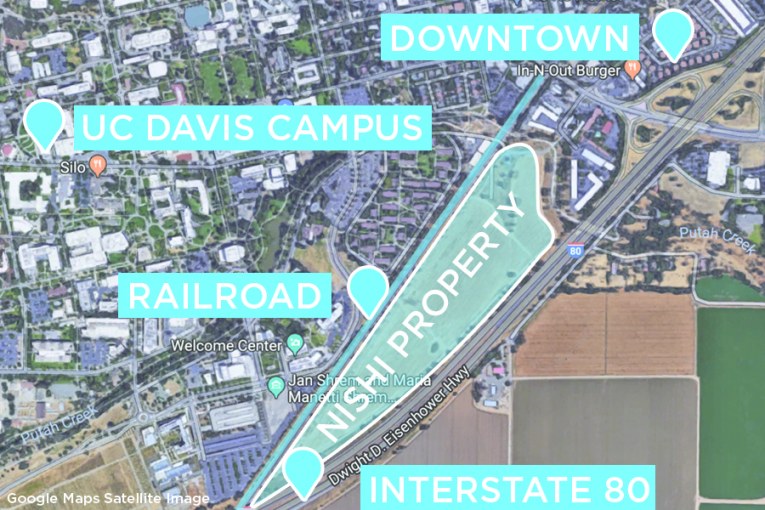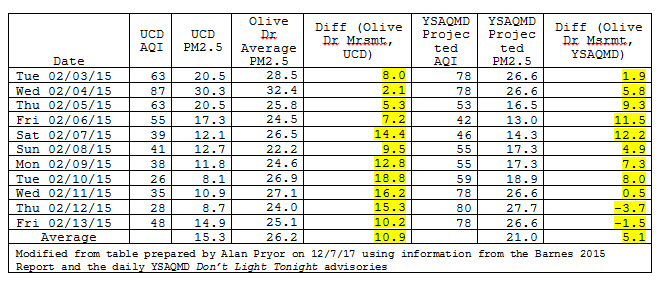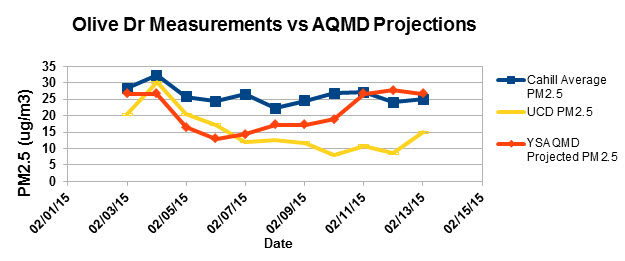
By Roberta L. Millstein
Proponents of Nishi – some of whom are apparently affiliated with the Nishi developers, since they testified as part of the developers’ presentation to the Planning Commission – have sought to downplay the poor air quality and associated health risks (including asthma, heart disease, and cancer) that residents would be exposed to at Nishi.
Here I respond to those claims by highlighting four issues: wind direction, air quality measurements, questionable assumptions about mitigation & residents, and assumption of risk.
1. Wind direction: Nishi proponents claim that winds are from the SW only 5% of the time:

However, the implied claim that only the winds from the SW matter does not pass the sniff test:

Source: The California Aggie
A quick glance at the map shows that any wind from a southerly direction will impact Nishi (freeway pollutants) and any wind from a northerly will as well (railways pollutants). But in any case, this is hypothetical. What really matters are the actual pollutants at the site.
2. Air quality measurements: The EIR cites the study done by David Barnes in 2015, February 3, 6:20 PM to February 13, 9:20 PM. There are at least two limitations to these data:
- Measurements were only taken for 10 days, so it is unclear how representative those days would be of days throughout the year.
- Measurements were taken at an adjacent site on Olive Drive, not at Nishi itself; thus, the measurements were not taken adjacent to where the freeway is elevated and to where the freeway narrows from 6 lanes to 3, causing frequent braking.
Nevertheless, the data are suggestive:

Seen graphically (graph modified from Alan Pryor):

The data show that the PM 2.5 measurements at Olive Dr are consistently higher than measured by UCD & generally higher than measured by YSAQMD – not just “5% of the time.”
Moreover, Barnes stated that a “peak in ultra-fine [0.09 to 0.0 μm] elements extends from Friday afternoon to late Saturday. This is the time most likely to be affected by weekend traffic. This is the only time during the study the site was exposed to the weekend traffic and it shows up clearly as the largest concentrations in the ultra-fine signal” (Barnes 2015, p. 9).
But we’re missing measurements of the worst case scenario: we have no measurements of days when there is bad air quality in the region and there is weekend (Tahoe) traffic.
We need additional testing at the Nishi site itself – as unanimously recommended by the NRC – and for longer than 10 days.
3. Questionable assumptions about mitigation & residents. Nishi proponents have made the following questionable assumptions:
- Claim: Exposure to pollutants will be mitigated –
- This assumes a highly optimistic scenario for the vegetative screen, ignoring the “at least 15 yrs” needed for growth, death due to drought and pests, etc., real-world deployment vs. laboratory.
- This assumes that residents will always keep their windows closed. But why should they? Informing residents of health risks is not part of the proposal – although it was unanimously recommended by the NRC.
- Claim: Residents will be young adults, healthy, residing only at Nishi for a short time.
- This assumes that residents will not get pregnant.
- This assumes that residents will be undergraduates. But residency will be open to all – grad students, young professionals – really, anyone who pays rent.
- This assumes that young adults do not have health problems. In fact, many of them do. Asthma, in particular, is increasing in prevalence in the U.S., and exposure to particular matter is thought to be one of the causes.
- This assumes that there are no short-term risks. That assumption is particularly questionable for asthma. Note all the “don’t light tonight” and “spare the air days” that warn people with respiratory conditions to stay inside. Based on the data so far, many days would be “spare the air” days at Nishi.
- This assumes that residents will have lived in clean air prior to Nishi and will live in clean air afterward. Rather, this could be yet another batch of toxins in an increasingly polluted lifetime.
4. Assumption of risk. Nishi proponents claim that it’s up to future residents to decide whether to assume the risk as compared to other risks in their lives.
The fact of the matter is that future residents will not know about the risks. There is nothing in the proposal about informed consent. So they will not be “deciding.” They will reasonably assume that the government would not permit housing to be built in an unsafe area.
A residence is one of the most basic human needs. It should not expose one to risks. We can do better (even if we’ve not always done well in the past – past mistakes do not justify future mistakes). There are other sites in Davis, including on campus, that would be safer.
~~~~
In short: The data we have suggest that it would be unhealthy to allow residency at Nishi. Further study would better resolve the issue. The City Council should not put this on the ballot at least until further studies – which have been recommended since before the last vote – are done.
In short: The data we have suggest that it would be unhealthy to the city and population to allow continued unfounded fear of de minimis health risks to be a basis for blocking needed housing developments and needed commercial developments.
Yep… je d’accord…
There may be other legitimate reasons to oppose, but air quality/health is bogus… big time
I say again, I’m on the bubble…
Normal spacing of trees in a 2000′ frontage would be about 75 – 100. This plan will have over 700 trees. Most vegetative barriers are about 30′ deep; this one will be over 100′ deep as well as possible plantings in the CalTrans easement.
Save your breath/fingers, Don… some folk have their opinions/agendas in stone… more like ‘carbonite’ (yeah, Star Wars referent)… not open to facts, not open to reason… we just need to expose them before the vote… just not today… save the thought/knowledge… blog equivalent of ‘keeping your powder dry’…
Me, I’m still on the bubble…
But it is time to call the question…
“The data we have suggest that it would be unhealthy to allow residency at Nishi.” The data also suggests that it is unhealthy to reside in much of Davis, especially along the I-80 corridor. In addition, a site identified by Eileen Samitz on UCD land as potential housing as the identical problems. Someone needs to step forward with an analysis that shows that Davis is a mortality/morbidity hot spot for the diseases associated with these air quality conditions to demonstrate that this issue is of real concern. In addition, someone needs to show a study that demonstrates that there is a statistically significant increase in risk from a short term exposure (2-3 years) over a lifetime of other exposures. (Regardless of whether the residents are students or not, their tenancies will largely be short compared to home ownership, or even single-family rentals.)
Finally, air quality is actually improving in the state. It is a myth that air quality is getting worse. One only needs to realize the huge increase in air clarity over the last 30 years to know that. (I have a story about traveling to LA in the early 1980s and then again over the last 8 years that illustrates that point.)
Yep…
Yes, here’s some of the data provided by Larry F. Greene:

It would be interesting to see the data from Don’s chart going back to the 1970’s.
In the mid 70’s when driving on the 210 freeway from Pasadena heading to Palm Springs you had no idea the San Bernardino mountains were even there since they were totally hidden by smog (same with the Diablo range east of San Jose most days). By the mid 90’s (after ~20 years of catalytic converters and ~10 years of CA Smog Checks) the mountains were almost always easy to see in both the Inland Empire and Santa Clara Valley.
It is interesting that Roberta says: “The fact of the matter is that future residents will not know about the risks.”
I’m wondering if Roberta thinks that UCD students (most who had over a 4.0 high school GPA) are idiots or if she has asked them and not one student told her that they think the air on a site in Davis located between the railroad tracks and the I80 freeway will be any cleaner than the air on a farm in the Capay Valley…
Even more telling when a large portion of the Yes crowd for Nishi is from the student body itself. I would ask those that oppose this project to stop putting words in our mouths for the purpose of fear mongering and raising their property values.
One of my recently-UCD-graduated with a high GPA – comparative literature – roommates turned on the extra fan we have to ventilate the kitchen. The fan is on a window sill – but he didn’t open the window so that the system would work. Some people know some things and not others.
So that means students are incapable of speaking for themselves?
No Aaron… the problem is liberal arts majors… an engineering/science student would know better (tongue 90% in cheek!)…
Your main point is spot on, Aaron… when I was a UCD student, I chose to vote in my home precinct… never figuring that I’d come back to Davis and live here for nearly forty more years… ya’ never know…
Prof. Cahill seemed to believe it was important to state that Salocks was an expert on meth. To be fair, we should know Millstein’s scientific expertise on toxicity and/or air quality. Millstein has long campaigned against Nishi and has aligned herself with landlords who benefit from the tight housing market. However, She seems to believe that the scientific opinion of an expert should be in question merely because they were part of the presentation to the Planning Commission. Her answer appears full of hypotheticals and the assumption of worst case scenarios. If we limited housing to areas where there was absolutely no risk, nothing would be built – no housing in the Bay Area, because of freeways and that troublesome huge fault line running through, nothing in the hills or mountains, because, you know, fires and bears, no housing anywhere in central Ca, because air pollution again and crop dusting, no housing near any transportation hubs due to air quality, but commute by car with all its risks is OK. Southern CA is completely out of the question. No housing on Nishi, but 100 feet away is OK, because the wind stops at the railroad tracks on the days the wind blows across the freeway. Sure.
When Sharla says: “If we limited housing to areas where there was absolutely no risk, nothing would be built” it nails down why the protect our equity/protect rents for dumpy apartments/protect the ability to rent a garage with a litter box for $500/month crowd pretends to care about the (fake) “risk” to kids living at Nishi it is because they want “nothing to be built”…
Salocks stated the other day in the media that apartments at Nishi will have MERV 13 air filters. These have only 75% efficiency with 0.3 to 1.0 micron particulate matter. The EIR mitigation requires 95% efficiency at removing 0.1 micron or smaller particles, also known as ultra fine particulate matter or UFP’s. It seems fair to conclude that MERV 13 filters – which have been available for at least 30 years or so – do somewhat less well with particlates three or more times smaller than 0.3.
In the final staff report at the meeting yesterday evening, the figures above such as “95%” were scrubbed, and replaced with e.g. “very clean”. About the issue of equipment, systems and methods to clean the air inside apartments in agreement with the twice-approved EIR, staff said “The mitigation measure establishes the standard for filtration, but not the methodology. The exact mechanisms would be verified at the time of building permit. As technology improves, the building designers would be able to adapt to the specific needs of the project at that time, and the tools might very well shift over time.”
How can the mechanisms for filtering 0.1 micron and smaller particulates improve from about as low as 65 to 75% (MERV 13, mentioned by Salocks) or about 70% in a active, occupied, real-world situation apt/98% in a closed, sealed, wind tunnel (testing by Cahill) to 95% within the next few years for a building which where Brett Lee yesterday said students would close windows often (not all the time, meaning it’s “active”) before a building permit is issued? Will the developers have their own lab? They’ve refused Cahill’s help in testing at the site itself and I hope that they are not considering Salocks for supervision of any sort of any lab as he is not even able to understand the basics – available in their description on Amazon – about MERV 13 air filters. They are not going to develop any technology for this. They are going to – at best – recommend that students close their windows.
In terms of “state-of-the-art” – which is how Salocks described a system that includes MERV 13 filters – they are as good as a pennyfarthing/high wheeler is… compared to a horse. But 130 years ago a better bicycle came along – the “safety bicycle” – with two wheels the same size, pneumatic tires and so on. This is the tech that facilitated the real bicycle revolution – and bicyclegalitarianism – of the next several decades before it was quashed by cars.
So it’s perhaps appropriate that – in a city which uses archaic, functionally-sexist technology as its symbol – we use old technology to attempt to reduce the negative effects of the vehicle that virtually destroyed the safety bicycle’s promised in most cities of the world.